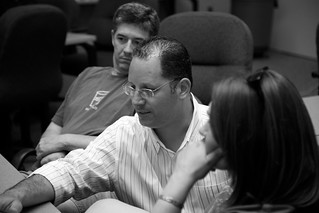What I was trying to do here was show two tools, flickr and wikis. I discussed how I think about using them in a pedagogical context and how the same approach can be used to think about using any new tool.
I was up until 3am the night before preping the presentation. What was really cool was an email I received from the folks at Slideshare to tell me this slideshow was featured on their site ... 13 hours after it was uploaded; 179 views at the time. It's up to 797 as I write this.
One of the things I've written about often here is the practice I try to instill in my students of "Watch it. Do it. Teach it." The good folks at pbwiki gave me three wikis, worth $250 each, to give away. (They said I could keep one for myself but I decided to give them all away.) Slide #50 shows how I'm giving them away. I ended this presentation by saying to the teachers in the room: "You watched it. Now you'll do it. (The best three will get the wikis.) But then take it with you back to your kids and teach it."
I still have a wiki to give away so if you were in my session you can still wiki a wiki. Please email me with your flickr picture and wiki urls when you're done. The two winners of the Gold Level wikis are:
Dennis Richards and Claudia Estrada.
Congratulations!!
The audio content (my student's voices) isn't here but almost all the images are also links.
The Missing Links
Slide #39: http://pc30sf06.pbwiki.com, http://apcalc06.pbwiki.com, http://am40s.pbwiki.com
Update August 4, 2007
The winner of the final wiki-give-away is Debbie Bates. Congratulations Debbie!!
- 7/28/2007 01:39:00 pm
- 2 Comments






